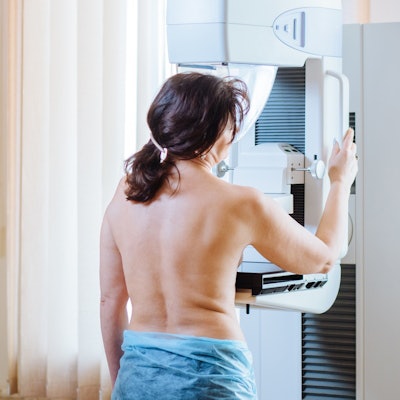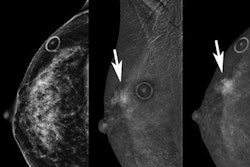
Less than 3% of early-stage breast cancer patients experience disease recurrence during five years of follow-up, and recurrence is more likely to be detected through mammography or patient symptoms than through physical clinical breast exams, a study published June 28 in Clinical Breast Cancer found.
Researchers led by Dr. Grace Makari-Judson from Baystate Medical Center in Massachusetts wrote their results encourage reassessing clinical guidelines that call for clinical breast exams every six months. It also gives a starting point for studying telehealth in survivorship care.
"Elimination of the frequent, routine, clinical breast exam or physical exam will reduce the necessity for physical visits and substantially reduce healthcare costs and improve the patients' safety and quality of life," Makari-Judson and colleagues wrote.
Women treated for early-stage breast cancer have an overall five-year survival rate of 98% for stage I cancer and 92% for stage II cancer. Follow-up visits for breast cancer survivors are intended to identify local recurrence, as well as to detect both distant and contralateral primary breast disease.
The National Cancer Center Network (NCCN) and the American Society of Clinical Oncology (ASCO) don't recommend using laboratory tests, tumor markers, or PET/CT scans in asymptomatic patients. Instead, regular clinical examination and annual mammography are recommended. However, limited data exist to support clinical breast examination.
Researchers also wrote that telemedicine's rapid rise in use from the COVID-19 pandemic necessitates clinicians to further review their practice guidelines to determine which patients would benefit from in-person physical exams.
Makari-Judson et al wanted to find out the presentation mode of second events in early-stage breast cancer patients experiencing local recurrence, new contralateral primary, or distant disease.
They looked at data from 351 early-stage breast cancer patients who were diagnosed between 2010 and 2015 with either ductal carcinoma in situ (DCIS), stage I, or stage II cancer. The women also had at least five years of follow-up.
Researchers defined second events as benign or malignant, with the latter consisting of contralateral primary, ipsilateral breast tumor recurrence, chest, wall recurrence, regional node recurrence, or distant relapse. Modes of detection included clinical examination and breast imaging, as well as patient complaints like lumps, pain, skin change, or nipple discharge.
The team found that 2.8% (10/351) of early-stage breast cancer patients experienced recurrence during five years of follow-up. Out of these, six were detected by patient complaints, two by physical exam, and two by breast imaging.
Out of the total, 63 women experienced second events, of which 15 had malignant events.
| Detection of second events by mode for women treated for breast cancer on at least five-year follow-up | |||
| Clinical breast exam | Patient complaint | Mammography | |
| Cancer recurrence (excluding contralateral primary cases) | 2 | 6 | 2 |
| Malignant lesions | 2 | 6 | 7 |
| Benign lesions | 0 | 16 | 32 |
For the malignant events, all four distant disease cases were detected by patient complaints. The five contralateral primary and three ipsilateral breast tumor recurrence cases were mostly detected by mammography (7/8).
Clinical breast exam, meanwhile, identified two out of two chest wall recurrences in post-mastectomy patients.
The study authors wrote that readily accessible and advanced breast imaging calls the value of routine clinical breast examination into question. They added that their findings support the idea that diagnosing local recurrence or new primary breast cancer is achieved through other detection modes such as medical imaging or patient complaints.
"Clinicians may be comfortable with telehealth visits and less frequent physical exams than the recommended every six months for the first five years," researchers wrote.
The team also called for further studies to be performed using a larger sample size from multiple cancer registries to confirm their findings.



















